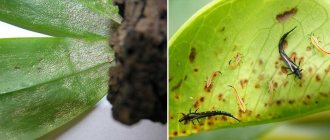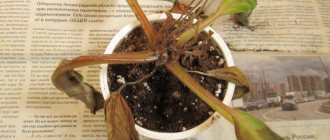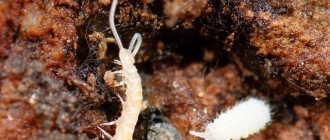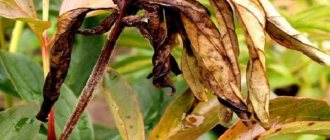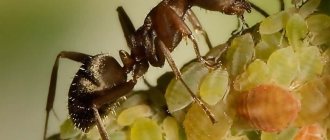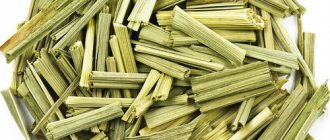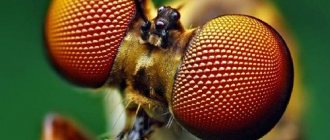Description and appearance
Poduras (or springtails, springtails) are ancient inhabitants of the Earth. These insects have existed for 400 million years. Poduras look like small segmented worms. The body length of adult insects is 0.2-3 mm; there are numerous microscopic bristles on the body.
Soil podurs live in pots with houseplants; they are white or light gray in color. This type of insect does not have wings; it has 3 pairs of legs.
The most interesting organ of these creatures is the furca, or jumping fork, located at the end of the body. At rest, it folds and is fixed on the abdomen. If necessary, the fork can be detached and used for jumping. Such jumps allow insects not to stick to the film of water on the soil surface.
Some researchers believe that jumping is part of the mating “dance” of these insects. It is surprising that with microscopic sizes, springtails can jump to a height of up to 3 cm.
The gnawing type mouthparts are located in the lower part of the head.
They reproduce by eggs, from which hatch larvae that look similar to adults, only smaller in size. After a few molts they reach sexual maturity.
Interesting fact! Until the mid-18th century, springtails were considered worms. Only the naturalist Carl Linnaeus was the first to classify poduras as wingless insects.
Appearance
Effective methods of control
The main thing is to figure out why springtails appeared at home, in open or closed ground.
The main reason is excess soil and air moisture. To combat pests, you will have to eliminate the factors that attract insects. How to proceed:
Folk remedies and recipes
It is not difficult to repel pests from orchids, violets, and camellias when using natural ingredients. Flower growers share their secrets of fighting tiny parasites.
Proven methods:
potato bait. The method is simple: divide the raw tuber into two halves, place the potatoes cut side down, and check the trap after 3-4 hours. Tiny insects actively gather around potatoes. The owners should quickly cover the piece of tuber with a bag or glass and remove the container along with the insects
It is important to act quickly, carefully, and remember: springtails on orchids, gloxinias, azaleas do not stay in one place for a long time, they jump to a new area,
wood ash against poisons. A good remedy for reducing the number of pests and reducing soil moisture
Directions for use: spread ash no more than 1 cm over the soil surface, reduce watering, reduce air humidity to optimal levels. For azaleas and camellias that prefer soils with high acidity, you should not use a natural component.
Preparations to combat springtails
Traditional methods are effective and safe for plants, but when the colony is large, potato baits and sprinkling the soil with wood ash do not give the desired result. Parasites actively gnaw at the roots, suck out the juices, and the plant weakens before our eyes.
In a difficult situation, it is important to treat the flower with proven drugs in a timely manner. Find out how to remove food moths from the kitchen using folk remedies and chemicals. Find out how to remove food moths from the kitchen using folk remedies and chemicals
Find out how to remove food moths from the kitchen using folk remedies and chemicals.
How to provide first aid and how to treat allergies to insect bites is written on this page.
Go to https://parazitam-stop.com/sad/rastenija/kapustnitsa.html and read about the reasons for the appearance and rules for controlling the cabbage butterfly in the garden.
Effective compositions for combating springtails:
Dimilin. Low-toxic product, active ingredient – diflubenzuron 250 g/kg. Broad-spectrum insecticide, insect growth regulator. Release form: wettable powder. A new generation drug with a residual effect of up to 40 days. The product is safe for people and animals (you should still not forget about measures to protect the skin, respiratory organs, and eyes), and quickly decomposes in water and soil. Regent. The product contains the active component fipronil, which disrupts the transmission of nerve impulses, causing paralysis in harmful insects. A contact-intestinal insecticide destroys a colony of pests in a few days. The drug is sold in two forms: ampoules with concentrated liquid and powder
When processing the soil, be careful; be sure to protect your eyes, respiratory organs, and skin from drops of the solution. Bazudin
A long-acting drug protects plants from many soil pests
Bazudin. A long-acting drug protects plants from many soil pests
Active substance – diazinon, 100 g/kg. A hazard class 3 product with a pungent odor. Granules have a complex effect on parasites and pests. To kill insects in flowerpots with indoor flowers, dig granules to a depth of 1 cm. Podurs die within a day after using the drug, the residual effect lasts up to six weeks. A contact-intestinal insecticide with translaminar action does not harm plants.
Reasons for the appearance of dupes
Podurs can live on indoor plants unnoticed in small numbers, without showing themselves in any way. They begin to actively reproduce in waterlogged soil. This happens due to:
- excessive, abundant watering (overflow);
- stagnation of moisture in the tray, the lower part of the flowerpot (due to improperly arranged drainage);
- high air humidity, especially in combination with low temperature, large temperature changes during the day;
- excess nitrogen-containing compounds in the soil (excess organic fertilizers);
- clogging of the pot with organic matter (dead, diseased parts of the plant);
- the presence of moss, mold, fungi in the soil.
Pest on violets
Springtails are present in almost every indoor plant soil. Several miniature individuals are difficult to notice; they leave no signs of their existence. As humidity levels rise, adults begin to reproduce intensively. In damp soil, the roots rot, and rotten organic matter is the main source of food for fools. The number of springtails increases, they begin to jump, appear floating in trays of water. The damage from springtails increases at low room temperatures. Unfavorable conditions slow down the growth and regeneration of indoor plants. Even minor damage turns into serious problems.
Heavy acidifying soil in pots with violets is a violation of agrotechnical growing conditions. Some species of fools cause damage to young violet seedlings. Damaged plants become vulnerable to diseases and other pests. Springtails are also carriers of fungal spores that cause disease.
Why are springtails dangerous for plants and the damage they cause?
The appearance of podura in flowers in small quantities should serve as a signal to gardeners that the plants are being kept in improper conditions. Springtails are herbivorous decomposers, that is, they feed on dead organic matter. At the same time, organic substances decompose into simple chemical compounds, enriching the soil. Their diet at home includes:
- dead above-ground and underground parts of the plant (roots, leaves, etc.);
- moss;
- fungus and mold;
- algae growing on the surface of waterlogged soil.
When there are too many springtails, they may not have enough food, and they begin to eat young shoots and roots of the plant. In conditions of excess humidity this can lead to:
- rotting;
- weakened immunity;
- development of diseases (viral and microbial).
Development of the disease
How to recognize
Certain signs will help you suspect the appearance of springtails on indoor flowers:
- with high humidity, a white coating is noticeable on the soil surface, and tiny insects swarm there,
- parasites grow up to 2 mm in length, jump high, actively move along the ground,
- Depending on the species, podars range in color from almost white to brown. The body of parasites is elongated,
- tiny insects rarely climb to the top of plants and spend most of their time on the surface of the soil in a flowerpot. With active reproduction and an abundance of moisture, pests “occupy” the root system, suck out juices, and damage the top layer of stems.
Types of springtails:
- white. The insect feeds on the top layer of soil and often appears in greenhouses, greenhouses, where humidity is constantly increased,
- vegetable. The parasite damages ornamental crops in greenhouses and interferes with the development of seedlings. Insects often live in summer cottages,
- mushroom The pest is dangerous for young shoots, seedlings, champignons, and bulbous flowers.
With a small number of parasites, there is practically no serious damage to flowers. If a colony of pests quickly increases, then there is a danger to the growth and development of plants.
Negative effects of springtails:
- under favorable conditions: high humidity, temperatures from + 22 to + 25 degrees, insects multiply quickly, penetrate not only into the soil, but also move to the leaves and stem. Parasites actively suck out juices, gnaw on greens,
- if the root system is damaged, the plant weakens, receives less nutrients,
- affected areas are gateways for the penetration of dangerous microbes. Weakened violets, orchids, and azaleas often suffer from fungal diseases.
How to get rid of idiots?
When springtails are detected, quick measures are necessary to prevent their mass reproduction and spread throughout the home greenhouse.
The first step is to transplant the affected plant into fresh soil. The pot and root system need to be disinfected: pour boiling water over the container, dip the roots in a weak solution of potassium permanganate for half an hour.
If poduras are visible only in one pot, this does not mean that they are not in others. It is necessary to carefully monitor the remaining plants in order to notice the spread of pests in time.
Traditional methods
The first way to get rid of springtails in a pot is as follows:
The pot is immersed in a large container of water so that the water covers it completely. The plant is not removed from the soil. Podurs float to the surface and then must be manually collected and destroyed.
Attention! This method will be effective with a small number of pests. Also, during this procedure, light fractions of the substrate float (expanded clay, perlite, peat).
Washing pots and trays with hot water and soap can also be considered a folk control method.
For another method of destroying fools in the soil, you will need raw potatoes. The tuber is cut in half and the halves are placed cut side down on the soil surface. After 2 hours, the potatoes must be lifted, the stuck springtails must be removed (rinsed), and placed back. Repeat the procedure until all pests are collected.
To get rid of annoying insects, the soil in the pot can be dried and deoxidized. To do this, you need to sprinkle a layer of sand and/or sifted wood ash on the surface.
Watering the soil with an infusion of tansy and celandine (2 tablespoons of herb per 1 tablespoon of boiling water) is carried out once a week, at least 4-5 times.
Biological agents
A biological product such as Fitoverm will help fight fools in the soil. The enteric insecticide aversectin is obtained from soil fungi, so it is considered an environmentally friendly method of pest control.
Attention! The packaging of the drug does not indicate that it is intended to combat podurs, however, the experience of flower growers shows that Fitoverm effectively fights these soil inhabitants. To spray one plant and soil in a pot, the solution is prepared at the rate of 2 ml (1 ampoule) per 100 ml of water.
Fitoverm
Chemicals
Chemical pesticides are effective remedies for fungus in the soil.
The following medications will help get rid of pests:
- Bazudin, Pochin, Grom-2 (in powder form) are scattered over the soil surface, mixed with the top layer for better distribution;
- Mospilan is an enteric contact pesticide, the active ingredient is acetamiprid, used for spraying on plants and on the soil surface,
- Aktara (active substance thiamethoxam), Inta-vir (active substance cypermethrin) are systemic insecticides. The concentrate is diluted with water according to the instructions. Water the soil with the solution and spray it onto the plant.
Attention! Treatment with chemicals must be carried out in the absence of children and pets, using personal protective equipment.
Podura in a pot of orchids
The most common option is the appearance of nimble pests on orchids growing in moss. If springtails are noticed on the substrate, this is a signal that the conditions of the plant have been violated. Poduras appear on an orchid in several cases:
- The soil is waterlogged, which leads to rotting of roots, stems and pseudobulbs, and infectious diseases may subsequently arise.
- The flower does not receive enough sunlight, so it does not have time to use up moisture during the period between waterings.
The desire to quickly destroy pests arises not only because of their potential threat to plants, but also because of their unsightly appearance. How to get rid of dura in orchids? To do this, it is recommended to replant the plant. Before the procedure, it is necessary to wash the root system with warm water. This will wash away eggs and larvae, invisible due to their small size. During transplantation, you can clearly see the roots. Rotten and dried parts are removed, the fabrics are cleaned to a healthy green color. Treated areas must be disinfected. Most often, activated carbon powder is used (to prepare it, you need to crush several tablets purchased at the pharmacy).
Interesting fact. Springtails can be beneficial; they are placed in soil contaminated with heavy metals for gradual cleansing.
The orchid should not be returned to its original place; it is better to move it to a more illuminated area. If it is not possible to improve natural lighting, phytolamps are installed. This is especially true in autumn and winter during the short photoperiod.
Preventive actions
To prevent podurs from appearing in pots (or from re-inoculating), it is necessary to maintain optimal temperature and humidity parameters. Perhaps this is the main preventive measure.
It is also worth paying attention to the following points:
- It is better to purchase new plants in trusted stores and nurseries;
- the condition of the plants and substrate in pots must be carefully monitored;
- do not overdo it with fertilizing, provide the plants with a period of rest;
- dead parts of plants must be promptly removed and the soil loosened;
- create proper drainage in flower pots, prevent moisture from stagnating in the pot or tray;
- select a pot (plant pot) in accordance with the size of the root system;
- periodically carry out preventive treatments with herbal insecticides and growth stimulants in order to improve plant health and increase resistance to various pests and diseases.
Morphology
Springtails got their name due to a special jumping organ (jumping fork) located on the underside of the abdomen. The fork is held in a “cocked” state by a special hook. If necessary, the fork is released and, hitting the ground, throws the collembola forward and upward. Some springtail species have an elongated fusiform body shape. They are traditionally called fools. The other part is distinguished by a rounded abdomen and a spherical body; they are usually called sminturs. In a strict sense, this is not entirely correct. Sminturs are only part of the springtails that have this spherical body shape.
Springtail larvae completely repeat the body shape of adult individuals, differing from them only in size and maturity.
The color of springtails (podur and smintur) is very diverse. Most species have a whitish, gray, yellowish, or brownish color, sometimes with a metallic sheen. Representatives of some genera may have a marbled pattern, or less often one or more transverse stripes. Some mints may have a clear dot pattern.
When growing indoor plants, most often found are white, grayish in color, sometimes with a greenish or silver-metallic sheen.
Photo 2. Jumping fork.
Damage caused by fools
If there are few insects, then you should not expect much harm from them. If the number of springtails increases sharply, the risk of losing the plant increases.
Nature of the negative impact:
- When conditions are particularly favorable, and this is possible at an ambient temperature of +22 to +25 degrees and high humidity, podars multiply quickly. At the same time, they begin to occupy the entire plant, penetrating even into the soil. They not only suck the juices out of the plant, but also gnaw on green shoots.
- When the root system is damaged and the plant begins to receive less nutrients, it stops developing.
- In addition, the affected areas of the plant are a kind of gate through which various bacteria can penetrate.
Prevention methods
To prevent the spread of insects that can harm orchids, you must follow these rules:
- Purchase indoor plants in specialized stores.
- Inspect new items before purchasing.
- When planting, do not forget about the drainage layer. It removes excess moisture.
- Follow the rules for caring for tropical plants.
- Water orchids sparingly.
- If necessary, replant flowers by replacing the substrate with a fresh one and washing the planting containers.
- Avoid excessive application of organic fertilizers.
